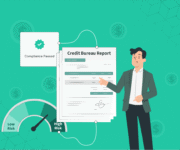You approved a borrower with a 750 credit score, perfect payment history, and 35% utilisation. Three months later, they defaulted. If your lending institution is facing similar incidents more often, you are probably missing evaluating the critical data points in credit bureau reports. According to RIS (Research and Information System for Developing Countries), unsecured loans accounted for 25.3% of total credit disbursed by Scheduled Commercial Banks in March 2024, up from around 18% in March 2016. Yet CareEdge Ratings projects a marginal deterioration in Gross NPA ratios, from 2.3% at the end of FY25 to around 2.3-2.4% by FY26, with personal loans facing particular stress.
Traditional analysis catches obvious risks but misses behavioural patterns that predict defaults months earlier. Even when two applicants hold identical credit scores, their future repayment behaviour may diverge completely. The difference lies in patterns hiding within credit bureau reports that standard analysis overlooks. Inquiry clustering, utilisation trajectories, account closure timing, payment velocity shifts, and credit mix evolution reveal borrower stress before conventional metrics flag it.
This blog presents an in-depth discussion of the five critical data points that experienced lenders miss and shows how automated credit report analysers, like Finezza’s AI-driven platform, extract these signals instantly to protect your portfolio.
5 Critical Data Points Lenders Often Overlook
The following data points in credit bureau reports hold predictive power that separates profitable portfolios from those facing mounting NPAs. Each reveals borrower behaviour patterns invisible to traditional analysis.
1. Credit Inquiry Patterns and Timing
Inquiry data is easy to skim past. Many treat it as a static number rather than a timeline of intent.
What to look for: Multiple inquiries within a short span across different product types signal desperation. A borrower approaching three personal loan providers, two credit card issuers, and one consumer durable financier within ten days has exhausted mainstream options. This pattern precedes default by 3 to 6 months consistently.
- Track inquiry spikes after rejections. Rejected borrowers often blanket the market immediately, approaching banks, then NBFCs, and then fintech platforms.
- Cross-reference inquiry dates with existing EMI due dates. Applications 5-7 days before major obligations indicate cash flow problems.
2. Credit Utilisation Trends Over Time
Single-point utilisation appears in every assessment. A borrower at 45% utilisation looks acceptable. But without historical context, you cannot distinguish someone trending down from 80% versus climbing from 20%.
What to look for: Month-on-month utilisation trends across 6-12 months reveal financial trajectory. A borrower maintaining 30% utilisation who suddenly jumps to 50%, then 65%, then 80% over three months shows deteriorating finances. Even with perfect payments, this trajectory predicts default within six to nine months.
- Monitor credit cycling patterns. Borrowers who max out cards monthly, pay them down, then immediately max them again, operate at their financial edge.
- Compare utilisation across product types. Sophisticated borrowers hide stress by maintaining low card utilisation while increasing personal loan balances.
3. Account Age Distribution and Closure Patterns
Lending teams usually check average account age. While a portfolio averaging three years old may seem stable, it obscures critical patterns in account opening and closing sequences.
What to look for: Recent closures of long-standing accounts signal major financial changes. When borrowers close accounts held for 5+ years, especially multiple accounts within 3-6 months, they are consolidating to manage cash flow.
- Monitor gaps between account opening dates. Multiple new accounts opened within 60 to 90 days, followed by older account closures, indicate credit limit exhaustion.
- Distinguish voluntary versus involuntary closures. Credit bureau reports mark this distinction. Involuntary closures from issuers signal problems your analysis missed.
- Watch for account age rebuilding. Borrowers who suddenly open multiple new accounts after maintaining older accounts for years might be rebuilding credit after previous defaults.
4. Payment Velocity and Settlement Patterns
Many reports highlight payment status as current or past due in 30/60/90 – day buckets. But they fail to show how quickly dues are cleared or how often settlements occur. Payment velocity remains invisible to traditional credit score analysis.
What to look for: Increasingly delayed payments within the “current” category reveal deteriorating health. A borrower who paid on due dates for two years, then started paying 5 days late, then 10 days late, and then extended up to 20 to 25 days clearly indicates declining capacity. This pattern predicts 90+ day delinquency within 3 to 6 months.
- Track partial payment patterns. Borrowers who consistently pay minimum amounts operate at their absolute limit. Previous settlements dramatically increase risk. Settlements indicate borrowers negotiated partial repayment, typically 40 – 60% of principal. Multiple settlements suggest habitual inability to meet obligations.
5. Credit Mix Evolution and Product Migration
Credit mix appears in reports as a current snapshot. You see home loans, vehicle loans, personal loans, and cards. But how that mix evolved reveals financial health better than the mix itself. Evolution shows a trajectory while the snapshots show only the current position.
What to look for: Migration from secured to unsecured products indicates increasing credit dependence or declining collateral capacity. Rapid growth in personal loans or BNPL products can reveal short-term dependency.
- Monitor product replacement patterns. Borrowers who close auto loans or home loans, then immediately open personal loans for similar amounts, are refinancing secured debt with unsecured debt.
- Watch for product stacking. Borrowers maintaining multiple personal loans, several cards, and various consumer loans simultaneously operate complex structures. When one product defaults, the entire structure collapses.
Why Traditional Manual Analysis Fails to Assess the Critical Data Points?
Here’s why traditional analysis, struggling to identify these patterns consistently, fails even experienced lenders:
- Spotting inquiry clusters, utilisation trajectories, payment velocity changes, or account migration patterns per file during the peak period is impossible. Analysts focus on obvious red flags and miss subtle signals.
- Critical interdependencies, like simultaneous utilisation spikes and new unsecured accounts, get lost in spreadsheets.
- Human reviewers also bring unconscious biases. The same application, reviewed by two analysts, generates different outcomes. Inconsistent interpretations across teams further create both losses from poor approvals and opportunity costs from good rejections.
- Manual reviews fail to cross-reference patterns across the entire portfolio to identify emerging trends.
These limitations aren’t a reflection of skill, but are a limitation of time, data volume, and human consistency. When scale and precision both matter, manual methods simply can’t keep up.
Here’s where intelligent automation becomes essential; not as a replacement for human expertise, but as its amplifier. Automated software solutions, like Finezza’s credit bureau data analytics platform, process bureau data with speed and precision that no manual workflow can match, revealing behavioural trends hidden within millions of data points.
How Advanced, AI-Backed Credit Bureau Analytics Solutions Can Help
Finezza’s AI-driven, cloud-based credit bureau data analyser offers a simplified view of the borrower’s credit scores and custom data analytics based on reliable credit data sources. It automates data extraction and interpretation, while analysing dozens of key data points, beyond just credit scores and payment history, to ensure every application receives the same analytical depth, free from human bias or fatigue.
Here are Finezza’s credit bureau data analytics’ top features:
Real-Time Pattern and Trend Analysis
The platform performs real-time trend analysis across borrowers’ complete credit histories. It detects early warning signs such as rising utilisation, frequent inquiries, or sudden product migrations, patterns that often appear months before a default.
With machine learning, the platform continuously refines its accuracy based on portfolio performance.
Adaptive, Customisable Risk Scoring
Finezza allows lenders to customise risk scoring models according to their portfolio characteristics. If inquiry patterns or utilisation ratios are strong predictors of default in your segment, the system automatically adjusts weighting to reflect that, keeping your risk models aligned with real-world performance.
Predictive Insights and Portfolio-Wide Intelligence
By correlating historical borrower behaviour with current data, Finezza generates predictive insights that help lenders take preventive actions early, tightening exposure, increasing monitoring, or declining risky applications before defaults occur.
Tangible Business Benefits:
- Credit evaluation time drops from 15-20 minutes to seconds
- Analysts can process more applications with consistent, bias-free accuracy
- Default rates fall as early warning signals are caught months in advance
- Scalability improves without compromising analytical depth
Final Thoughts
The complete narrative of credit bureau reports lives in inquiry timing, utilisation trajectories, account behaviour patterns, payment velocity shifts, and credit mix evolution. Lenders who extract and analyse these signals gain a substantial competitive advantage through lower default rates, faster decisions, and more accurate risk assessment. Credit bureau reports contain this intelligence already. You need the right tools to extract it systematically.
Finezza has spent years perfecting credit bureau analysis for Indian lenders. We support banks, NBFCs, fintech companies, and financial institutions across complete lending operations. Our end-to-end lending lifecycle management and credit evaluation services encompass loan origination and loan management systems, collection delinquency, bank statement analyser, and advanced credit bureau analytics. With this suite of intelligent technology solutions and deep domain expertise, we have processed millions of credit applications for clients, helping them reduce defaults while scaling operations efficiently. Our end-to-end lending solution portfolio also integrates seamlessly with existing systems through robust APIs and data pipelines.
Book a free demo today to understand how Finezza’s credit bureau analyser transforms credit assessment rapidly. Our team will demonstrate exactly how these five critical data points appear in our platform and how automated analysis catches risks your current process misses.




Leave a Reply